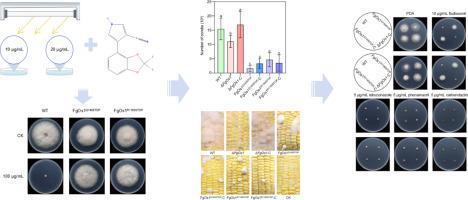渗透传感器样组氨酸激酶FgOs1的过早终止密码子突变赋予禾谷镰刀菌对氟恶菌腈的抗性
IF 4
1区 农林科学
Q2 BIOCHEMISTRY & MOLECULAR BIOLOGY
引用次数: 0
摘要
稻谷镰刀菌是谷物生产中的一种毁灭性病害,给粮食生产造成损失。氟菌腈是一种苯基吡咯杀菌剂,已被登记用于许多作物的病害管理。然而,禾草菌对氟恶菌腈的抗性机制尚未得到系统的分析。本研究通过证明渗透传感器样组氨酸激酶基因FgOs1的过早终止密码子突变是导致F. graminearum对氟虫腈耐药的致病因素,阐明了F. graminearum对氟虫腈耐药的分子基础。在fludioxonil抗性突变体中发现了两个独立的突变,导致FgOs1蛋白被截断:位于n端的FgOs1Q140STOP突变和位于REC信号域的FgOs1R1183STOP突变。同源基因替代和互补分析证实,这些突变特别赋予对氟恶菌腈(耐药因子>; 1000)的高水平耐药,而对戊唑唑、非那马克里尔或多菌灵没有交叉耐药。值得注意的是,fgos1突变菌株对渗透和金属离子胁迫表现出更高的敏感性,这表明过早终止密码子诱导的蛋白质截断损害了渗透调节和离子稳态途径。系统发育分析显示,突变残基在不同真菌物种中高度保守,强调了它们的功能重要性。这些发现揭示了FgOs1在抗真菌抗性中以前未被认识到的作用,并为开发创新策略来管理F. graminearum的氟恶菌腈抗性提供了关键靶点。本文章由计算机程序翻译,如有差异,请以英文原文为准。

Premature termination codon mutations in osmosensor-like histidine kinase FgOs1 endow Fusarium graminearum with fludioxonil resistance
Fusarium graminearum is a devastating disease in cereal production, causing a loss in grain production. Fludioxonil, a phenylpyrrole fungicide, has been registered for disease management of many crops. However, the resistance mechanism of F. graminearum to fludioxonil has not been systematically analyzed. This study elucidates the molecular basis of fludioxonil resistance in F. graminearum by demonstrating that premature termination codon mutations in the osmosensor-like histidine kinase gene FgOs1 are causative factors. Two independent mutations were identified in fludioxonil-resistant mutants, leading to truncated FgOs1 proteins: a FgOs1Q140STOP mutation locating at N-terminal and an FgOs1R1183STOP mutation locating at the REC signaling domain. Homologous gene replacement and complementation assays confirmed that these mutations specifically confer high-level resistance to fludioxonil (resistance factor > 1000) without cross-resistance to tebuconazole, phenamacril, or carbendazim. Notably, FgOs1-mutated strains exhibited heightened sensitivity to osmotic and metal ion stresses, suggesting that the premature termination codon-induced protein truncation impairs osmoregulation and ion homeostasis pathways. Phylogenetic analysis revealed that the mutated residues are highly conserved across diverse fungal species, underscoring their functional importance. These findings uncover a previously unrecognized role of FgOs1 in antifungal resistance and provide critical targets for developing innovative strategies to manage fludioxonil resistance in F. graminearum.
求助全文
通过发布文献求助,成功后即可免费获取论文全文。
去求助
来源期刊
CiteScore
7.00
自引率
8.50%
发文量
238
审稿时长
4.2 months
期刊介绍:
Pesticide Biochemistry and Physiology publishes original scientific articles pertaining to the mode of action of plant protection agents such as insecticides, fungicides, herbicides, and similar compounds, including nonlethal pest control agents, biosynthesis of pheromones, hormones, and plant resistance agents. Manuscripts may include a biochemical, physiological, or molecular study for an understanding of comparative toxicology or selective toxicity of both target and nontarget organisms. Particular interest will be given to studies on the molecular biology of pest control, toxicology, and pesticide resistance.
Research Areas Emphasized Include the Biochemistry and Physiology of:
• Comparative toxicity
• Mode of action
• Pathophysiology
• Plant growth regulators
• Resistance
• Other effects of pesticides on both parasites and hosts.

 求助内容:
求助内容: 应助结果提醒方式:
应助结果提醒方式:


